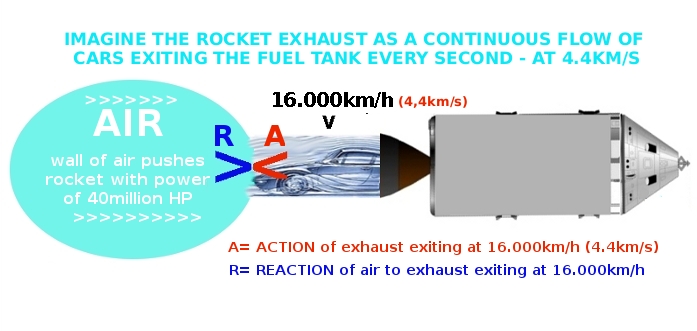dblitz wrote:Rockets work in a vacuum because rocketry does not operate by pushing against air, or anything else for that matter.
"ROCKETS DO NOT PUSH AGAINST AIR (2)"
NASA keeps denying the existence of air & aerodynamics
Here we go again. It seems that NASA's wackiest claim just won't go away:
"rockets do not push against air, whatsoever." 
Here's a real, amateur rocket taking off.
According to NASA,
it does not push against air - at all (???) :
"it is (exclusively) propelled by the recoil effect caused by its fuel being ejected out of its tank":
 "Steve Eves and his Saturn5-model amateur rocket launch": http://www.youtube.com/watch?v=uxgMhHOaUSY
"Steve Eves and his Saturn5-model amateur rocket launch": http://www.youtube.com/watch?v=uxgMhHOaUSY
Come, come, let's get real - and stop kidding ourselves.
Before we proceed, dear reader, let me ask you to open these two earlier posts of mine in separate windows - for reference:
"The Power of Air" http://cluesforum.info/viewtopic.php?p=2385809#p2385809
"40 MILLION HP - The Wondrous Power of Air" http://cluesforum.info/viewtopic.php?p=2385835#p2385835
Here's a brief summary of the main points illustrated / expounded in those two earlier posts :
A- Air drag increases exponentially with speed. Overcoming air drag is the
main opposing force encountered by an accelerating vehicle.
B- To propel a Porsche at 200km/h, its engine will need to use 4X as much horsepower as it needs to travel at 100km/h.
C- To travel at a hypothetical 16.000km/h (max exhaust velocity of the Space Shuttle engines), a Porsche would need
40 million hp.
D- Hence, if we can imagine a rocket's exhaust plume (roughly the same size/ frontal area / Cx of a Porsche) as a steady flow of Porsches pushing against the air below the rocket, it should be perfectly evident that this massive, 40 million hp air-displacing vortex IS THE MAIN FORCE WHICH PROPELS THE ROCKET THROUGH THE ATMOSPHERE :
 HOW DO SPACE-GOING ROCKETS REACH "ESCAPE VELOCITY"?
HOW DO SPACE-GOING ROCKETS REACH "ESCAPE VELOCITY"?
NASA tells us that the maximum exhaust velocity attainable with chemical propellants is 4,4km/s (or 16.000km/h). We are told that the far higher speed of 27.000km/h (the required, so-called "escape velocity") is easily reached because their rockets keep accelerating as they meet ever thinner air resistance (at 100km, air is 2,2 million times thinner than at sea level). Very well, so "less air-drag = faster rocket". But wait: wouldn't also the rocket's thrust force (as illustrated above), in all logic, decrease accordingly?
WHAT ABOUT GRAVITY? DOES IT CEASE TO EXIST AT 100km altitude (aka "the Kàrmàn Line") ?
No - apparently not. A rocket weighing, say, 100.000kg at sea-level - will still weigh 97.000kg at 100km altitude.
MISCONCEPTIONS
"Zero gravity" or even nearly zero gravity is a misnomer, and does not really exist anywhere in the universe. (...) For example, the force of gravity at 100 km altitude in Earth's orbit is actually 97 percent of what it is for people standing on the ground.
http://www.ehow.com/about_4798210_zero- ... facts.html
In spite of this - and amazingly enough - NASA claims that, once their spaceships (Space Shuttle and all) reach "escape velocity" (at around 100km of altitude), they can just switch off their engines - and thereafter keep orbiting indefinitely around Earth "for free", with no more fuel needed ! It is said that, once they exit the atmosphere (above 100km or so) at sufficient speed, they will start
'free-falling' around our planet (at a brisk 27.000km/h). Moreover, once inserted in the vacuum of space, their wondrous spaceships can nimbly maneuver / climb / descend / accelerate / & slow down at will - with utmost precision (for instance, when catching up & docking with the ISS, or when shooting the LEM back up from the moon surface to rejoin the Apollo Command Module, or when deciding to re-enter the atmosphere and return back to Mother Earth...).
I submit that all of these NASA claims are nothing but sheer science-fiction fantasy - and that rockets / spaceships (while working perfectly well within our atmosphere) may not be physically able to surpass the 100km altitude mark - let alone keep orbiting (with engines off) at hypersonic speeds - or much less propel themselves and maneuver in the vacuum of space. In doing so, (please note that I am respectfully observing our ol' friend Isaac's laws) :

I should probably also re-post here this old diagram of mine (based on NASA's own graphics) :

Source of graphics used for above diagram:
http://en.wikipedia.org/wiki/Rocket_engine




